Fracture Toughness Analysis of Aluminum (Al) Foil and Its Adhesion with Low-Density Polyethylene (LPDE) in the Packing Industry
Abstract
1. Introduction
2. Theoretical Model
2.1. Fracture Mechanics
2.2. Model of Modified Strip Yield
2.3. Fracture Toughness
2.4. Adhesion Behavior
3. Experimental Study
3.1. Material Preparation
3.2. Design of Experiment
3.3. Experimental Testing for Data Collection
3.4. Experimental Results and Discussion
3.4.1. Case 1: Aluminum Foil
3.4.2. Case 2: Aluminum Foil/LDPE (without Adhesion)
3.4.3. Case 3: Al-Foil/Adh/LDPE (with Adhesion)
3.4.4. Comparison between Case 2 and Case 3
4. Numerical Simulation
4.1. Material Parameters Calibration
4.2. Fracture Material Parameters Calibration
4.3. Numerical Results and Discussion
4.3.1. Aluminum Foil (No Crack)
4.3.2. LDPE
4.3.3. Aluminum Foil (5 mm Crack)
4.3.4. Aluminum Foil/LDPE Laminated (No Crack)
5. Results and Discussion
6. Conclusions
- Different material properties were determined in this study by developing physical test and FE modeling procedures. The experiments were carried out on Al-foil, aluminum foil laminated with LDPE, with and without adhesion. Material parameters were calibrated for use in the numerical test study. The design of experiment technique was used to determine the material’s Young’s modulus, plasticity, damage initiation, and damage evolution. For Al-foil, the theoretical result using LEFM and modified strip yield model was showing a close relation with the obtained experimental results.
- The fracture toughness KC obtained for the Al-foil with thickness of 9 microns was 6.39 MPam1/2. An earlier study on the same grade Al-foil reported the fracture toughness KC = 6.1 MPam1/2 for thickness of 6.42 microns.
- For the case of laminated Al-foil/LDPE (without adhesion), the behavior of the material in the numerical and physical tests was dynamic along the displacement and there may be number of reasons, such as the fact that Al-foil and LDPE were laminated by a lamination machine and were in contact with PET to avoid the burning and sticking of materials with paper. This may have caused the change in the material properties.
- Failure of Al-foil before the LDPE in case of Al foil/LDPE (without adhesion) cause the specimen oscillation, so vibration can also be a cause of change in material behavior when analyzed numerically.
- In the case of Al foil/Adh/LDPE, both materials broke at the same point so it can be concluded that the strong adhesion force between laminates can change the properties and the materials act as one.
Author Contributions
Funding
Institutional Review Board Statement
Informed Consent Statement
Data Availability Statement
Conflicts of Interest
Appendix A
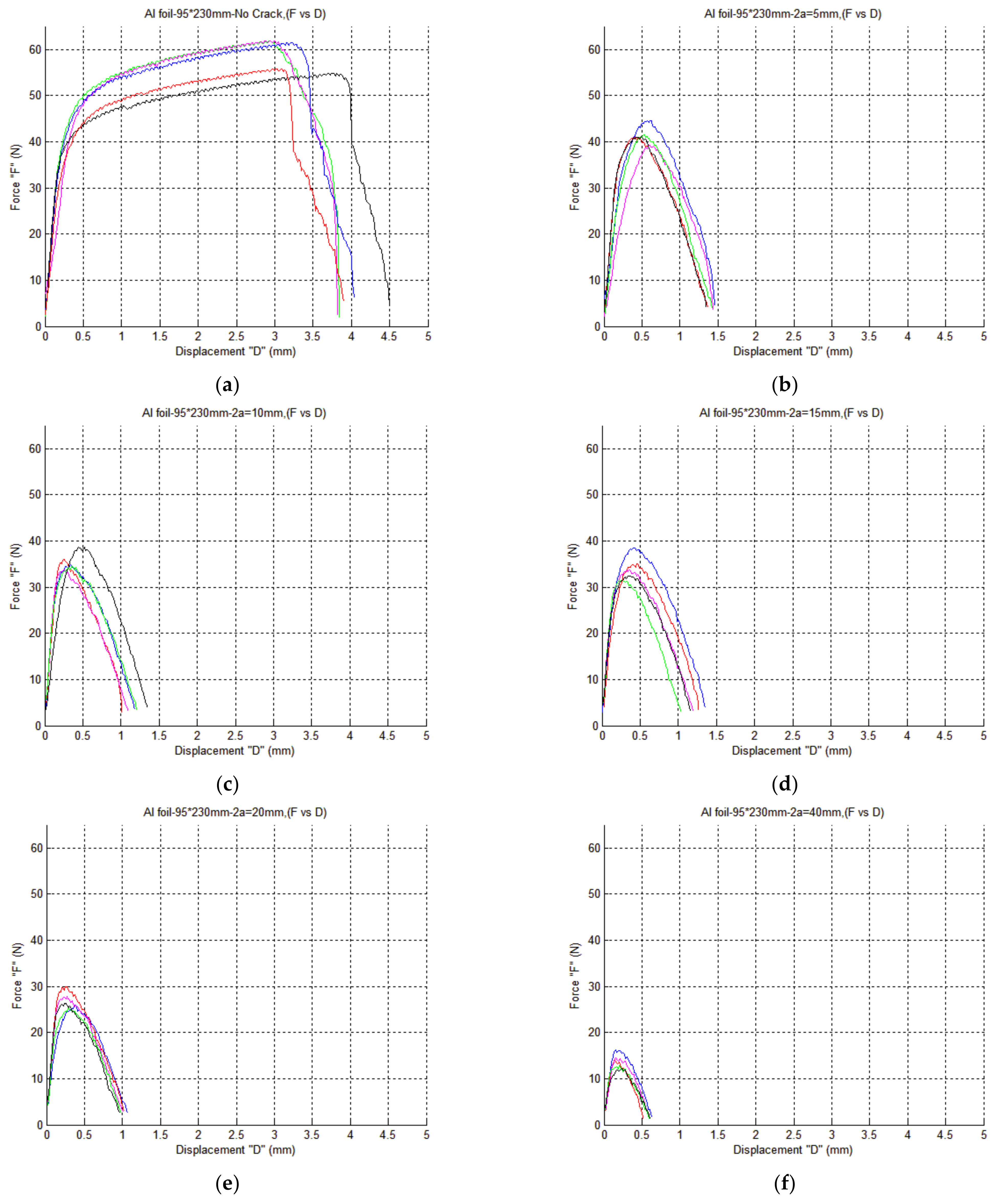
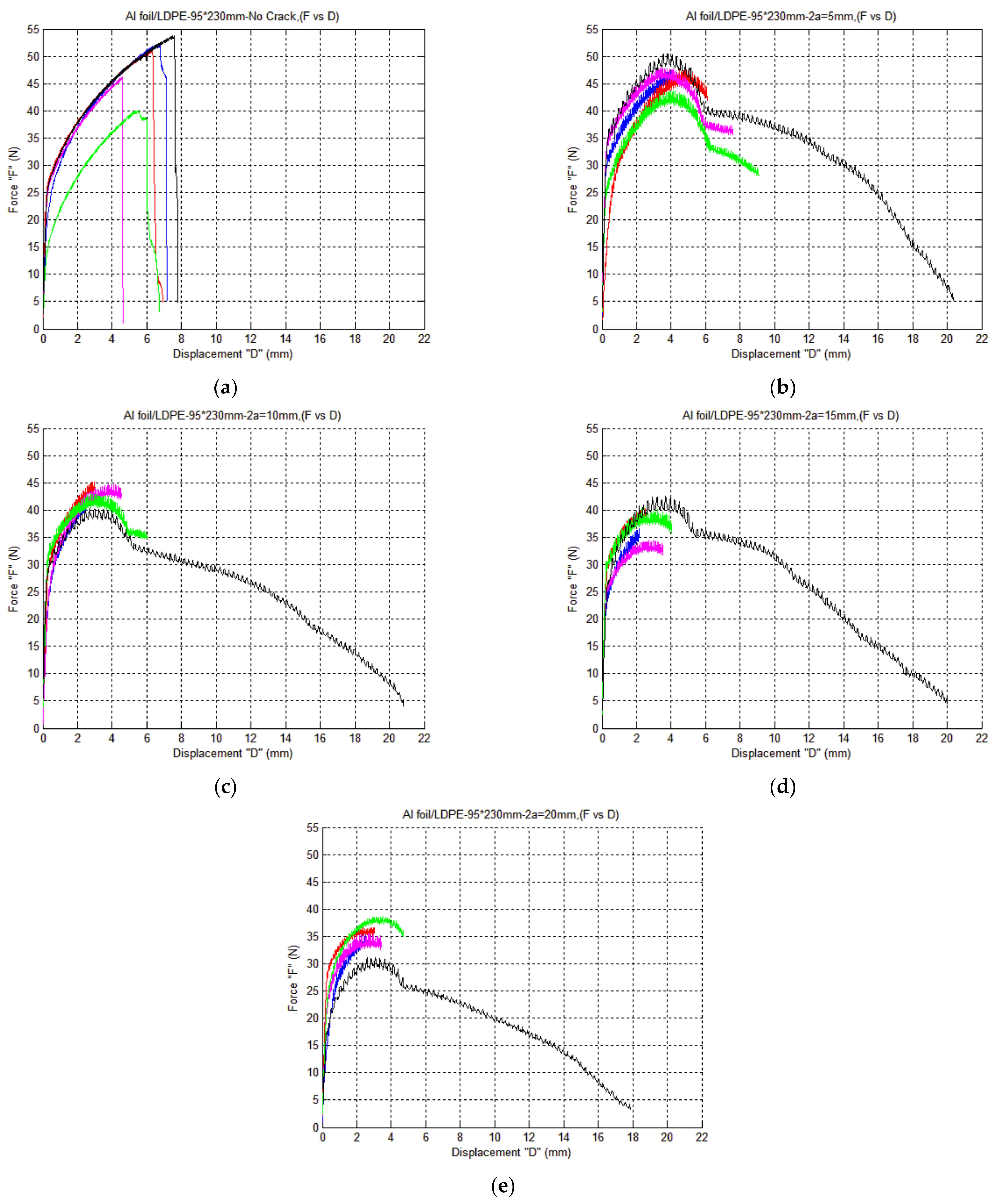

Appendix B
| Nos. | Yield Stress (MPa) | Plastic Strain |
|---|---|---|
| 1 | 36.19 | 0 |
| 2 | 42.54 | 0.0001096 |
| 3 | 45.12 | 0.000211 |
| 4 | 48.13 | 0.0003004 |
| 5 | 51.16 | 0.0004633 |
| 6 | 54.11 | 0.0007017 |
| 7 | 57.38 | 0.001147 |
| 8 | 60.35 | 0.00182 |
| 9 | 62.95 | 0.003004 |
| 10 | 64.77 | 0.004132 |
| 11 | 66.56 | 0.005547 |
| 12 | 68.58 | 0.007468 |
| 13 | 70.63 | 0.009318 |
| 14 | 72.12 | 0.01117 |
| 15 | 73 | 0.01246 |
| Nos. | Yield Stress (MPa) | Plastic Strain |
|---|---|---|
| 1 | 5.332 | 0 |
| 2 | 5.444 | 0.00134 |
| 3 | 5.68 | 0.0022 |
| 4 | 6 | 0.00427 |
| 5 | 6.16 | 0.00569 |
| 6 | 6.3 | 0.0065 |
| 7 | 6.459 | 0.0079 |
| 8 | 6.511 | 0.0083 |
| 9 | 6.62 | 0.0093 |
| 10 | 6.78 | 0.01107 |
| 11 | 6.90 | 0.0124 |
| 12 | 7.08 | 0.0147 |
| 13 | 7.14 | 0.0148 |
| 14 | 7.21 | 0.0164 |
| 15 | 7.328 | 0.0184 |
| 16 | 7.412 | 0.0193 |
| 17 | 7.553 | 0.0227 |
| 18 | 7.638 | 0.0246 |
| 19 | 7.80 | 0.0278 |
| 20 | 7.92 | 0.0313 |
| 21 | 8.02 | 0.0330 |
| 22 | 8.136 | 0.0365 |
| 23 | 8.26 | 0.04 |
| 24 | 8.35 | 0.0425 |
| 25 | 8.73 | 0.0696 |
References
- Islam, M.S. Fracture and Delamination in Packaging Materials: A Study of Experimental Methods and Simulation Techniques. Ph.D. Thesis, Blekinge Tekniska Högskola, Karlshamn, Sweden, 2019. [Google Scholar]
- Islam, M.S.; Alfredsson, K.S. Peeling of metal foil from a compliant substrate. J. Adhes. 2021, 97, 672–703. [Google Scholar] [CrossRef]
- Marsh, K.; Bugusu, B. Food packaging—Roles, materials, and environmental issues. J. Food Sci. 2007, 72, R39–R55. [Google Scholar] [CrossRef]
- Geueke, B.; Groh, K.; Muncke, J. Food packaging in the circular economy: Overview of chemical safety aspects for commonly used materials. J. Clean. Prod. 2018, 193, 491–505. [Google Scholar] [CrossRef]
- Shin, J.; Selke, S.E.M. Chapter 11 Food Packaging. Food Processing: Principles and Applications; John Wiley & Sons: Hoboken, NJ, USA, 2014. [Google Scholar]
- Brostow, W.; Lobland, H.E.H.; Khoja, S. Brittleness and toughness of polymers and other materials. Mater. Lett. 2015, 159, 478–480. [Google Scholar] [CrossRef]
- Kao-Walter, S. On the Fracture of Thin Laminates. Ph.D. Thesis, Blekinge Institute of Technology, Karlskrona, Sweden, 2004. [Google Scholar]
- Tryding, J. In Plane Fracture of Paper. Ph.D. Thesis, Lund Institute of Technology, Lund, Sweden, 1996. [Google Scholar]
- Hägglund, R.; Isaksson, P. Analysis of localized failure in low-basis-weight paper. Int. J. Solids Struct. 2006, 43, 5581–5592. [Google Scholar] [CrossRef]
- Isaksson, P.; Hägglund, R.; Gradin, P. Continuum damage mechanics applied to paper. Int. J. Solids Struct. 2004, 41, 4731–4755. [Google Scholar] [CrossRef]
- Islam, M.S.; Zhang, D.; Mehmood, N.; Kao-Walter, S. Study of shear dominant delamination in thin brittle-high ductile interface. Procedia Struct. Integr. 2016, 2, 152–157. [Google Scholar] [CrossRef][Green Version]
- De-feng, Z.; Md. Shafiqu, I.; Eskil, A.; Sharon, K.-W. Modeling and study of fracture and delamination in a packaging laminate. In Proceedings of the 3rd International Conference on Material Engineering and Application (ICMEA 2016), Shanghai, China, 12–13 November 2016. [Google Scholar]
- Li, T.; Suo, Z. Ductility of thin metal films on polymer substrates modulated by interfacial adhesion. Int. J. Solids Struct. 2007, 44, 1696–1705. [Google Scholar] [CrossRef]
- Li, T.; Suo, Z. Deformability of thin metal films on elastomer substrates. Int. J. Solids Struct. 2006, 43, 2351–2363. [Google Scholar] [CrossRef]
- Suo, Z.; Vlassak, J.; Wagner, S. Micromechanics of macroelectronics. China Particuology 2005, 3, 321–328. [Google Scholar] [CrossRef]
- Li, T.; Zhang, Z.; Michaux, B. Competing failure mechanisms of thin metal films on polymer substrates under tension. Theor. Appl. Mech. Lett. 2011, 1, 041002. [Google Scholar] [CrossRef]
- Shahid, S.; Gukhool, W. Experimental Testing and Materialmodeling of Anisotropy in Injection Moulded Polymer Materials. Master’s Thesis, Blekinge Institiute of Technology, Karlskrona, Sweden, 2020. [Google Scholar]
- Danielsson, M.; Parks, D.M.; Boyce, M.C. Three-dimensional micromechanical modeling of voided polymeric materials. J. Mech. Phys. Solids 2002, 50, 351–379. [Google Scholar] [CrossRef]
- Sedighiamiri, A.; Govaert, L.E.; Van Dommelen, J.A.W. Micromechanical modeling of the deformation kinetics of semicrystalline polymers. Polym. Sci. Part B Polym. Phys. 2011, 48, 1297–1310. [Google Scholar] [CrossRef]
- Chen, S.H.; Wang, T.C.; Kao-Walter, S. A crack perpendicular to the bimaterial interface in finite solid. Int. J. Solids Struct. 2003, 40, 2731–2755. [Google Scholar] [CrossRef][Green Version]
- Kao-Walter, S.; Ståhle, P.; Chen, S.H. A finite element analysis of a crack penetrating or deflecting into an interface in a thin laminate. Key Eng. Mater. 2006, 312, 173–178. [Google Scholar] [CrossRef]
- Kao-Walter, S.; Ståhle, P.; Hägglund, R. Fracture toughness of a laminated composite. Eur. Struct. Integr. Society. 2003, 32, 355–364. [Google Scholar] [CrossRef]
- Kao-Walter, S. Mechanical and Fracture Properties of Thin Al-Foil; Blekinge Tekniska Högskola Forskningsrapport: Karlskrona, Sweden, 2001; ISSN 11031581. [Google Scholar]
- He, G.; Li, J.; Zhang, F.; Lei, F.; Guo, S. A quantitative analysis of the effect of interface delamination on the fracture behavior and toughness of multilayered propylene–ethylene copolymer/low density polyethylene films by the essential work of fracture (EWF). Polymer 2014, 55, 1583–1592. [Google Scholar] [CrossRef]
- Iqbal, M.S.; Muhammadi, A.B. Tearing Fracture and Microscopic Analysis of Laminate Toward Sustainable Packaging. Master’s Thesis, Blekinge Institute of Technology, Karlskrona, Sweden, 2007. [Google Scholar]
- Skanse, H. Investigation of Mechanical Tearing and How it can Be Applied in Package Open Ability Prediction. Master’s Thesis, Lund Institute of Technology, Lund, Sweden, 2009. [Google Scholar]
- Karmlid, O. Simulation and Testing of Crack Sensitivity in TFA Packaging Material. Master’s Thesis, Lund University, Lund, Sweden, 2011. [Google Scholar]
- Min, H. Study of Two Models for Tearing Resistance Assesment Using Essential Work of Fracture Method; Blekinge Institute of Technology: Karlskrona, Sweden, 2008. [Google Scholar]
- Kao-Walter, S.; Dahlström, J.; Karlsson, T.; Magnusson, A. A study of the relation between the mechanical properties and the adhesion level in a laminated packaging material. Mech. Compos. Mater. 2004, 40, 29–36. [Google Scholar] [CrossRef]
- Kao-Walter, S.; Mfoumou, E. Fracture Toughness Testing of Non Standard Specimens; Blekinge Institute of Technology: Karlskrona, Sweden, 2004. [Google Scholar]
- Anderson, T.L. Fracture Mechanics Fundamentals and Applications, 3rd ed.; CRC Press Taylor & Francis Group: Boca Raton, FL, USA, 2005. [Google Scholar]
- Kao-Walter, S.; Ståhle, P. Fracture Behaviour of a Thin Al-Foil-Measuring and Modelling of the Fracture Processes. In Proceedings of the Third International Conference on Experimental Mechanics, Beijing, China, 15–17 October 2001; pp. 25–256. [Google Scholar]
- Dugdale, D.S. Yielding of steel sheets containing slits. J. Mech. Phys. Solids 1960, 8, 100–104. [Google Scholar] [CrossRef]
- Fracture Toughness. Center, N.E.R. Toughness. 2018. Available online: https://www.nde-ed.org/EducationResources/CommunityCollege/Materials/Mechanical/Toughness.html (accessed on 21 August 2020).
- Jemal, A.; Katangoori, R.R. Fracture Mechanics Applied in Thin Ductile Packaging Materials-Experiments with Simulations. Master’s Thesis, Blekinge Institute of Technology, Karlskrona, Sweden, 2011. [Google Scholar]
- Baldan, A. Adhesively-bonded joints and repairs in metallic alloys, polymers and composite materials: Adhesives, adhesion theories and surface pretreatment. J. Mater. Sci. 2004, 39, 1–49. [Google Scholar] [CrossRef]
- Creton, C.A. Materials science of pressure sensitive adhesives, materials science and technology. Process. Mater. 1997, 18, 434–439. [Google Scholar]
- Krenk, S. Non-Linear Modeling and Analysis of Solids and Structures; Cambridge University Press: Cambridge, UK, 2009. [Google Scholar]
- Systèmes, D. Introduction to Abaqus Scripting; Dassault Systèmes: Vélizy-Villacoublay, France, 2009. [Google Scholar]
- Shi, Y.; Swait, T.; Soutis, C. Modelling damage evolution in composite laminates subjected to low velocity impact. Compos. Struct. 2012, 94, 2902–2913. [Google Scholar] [CrossRef]

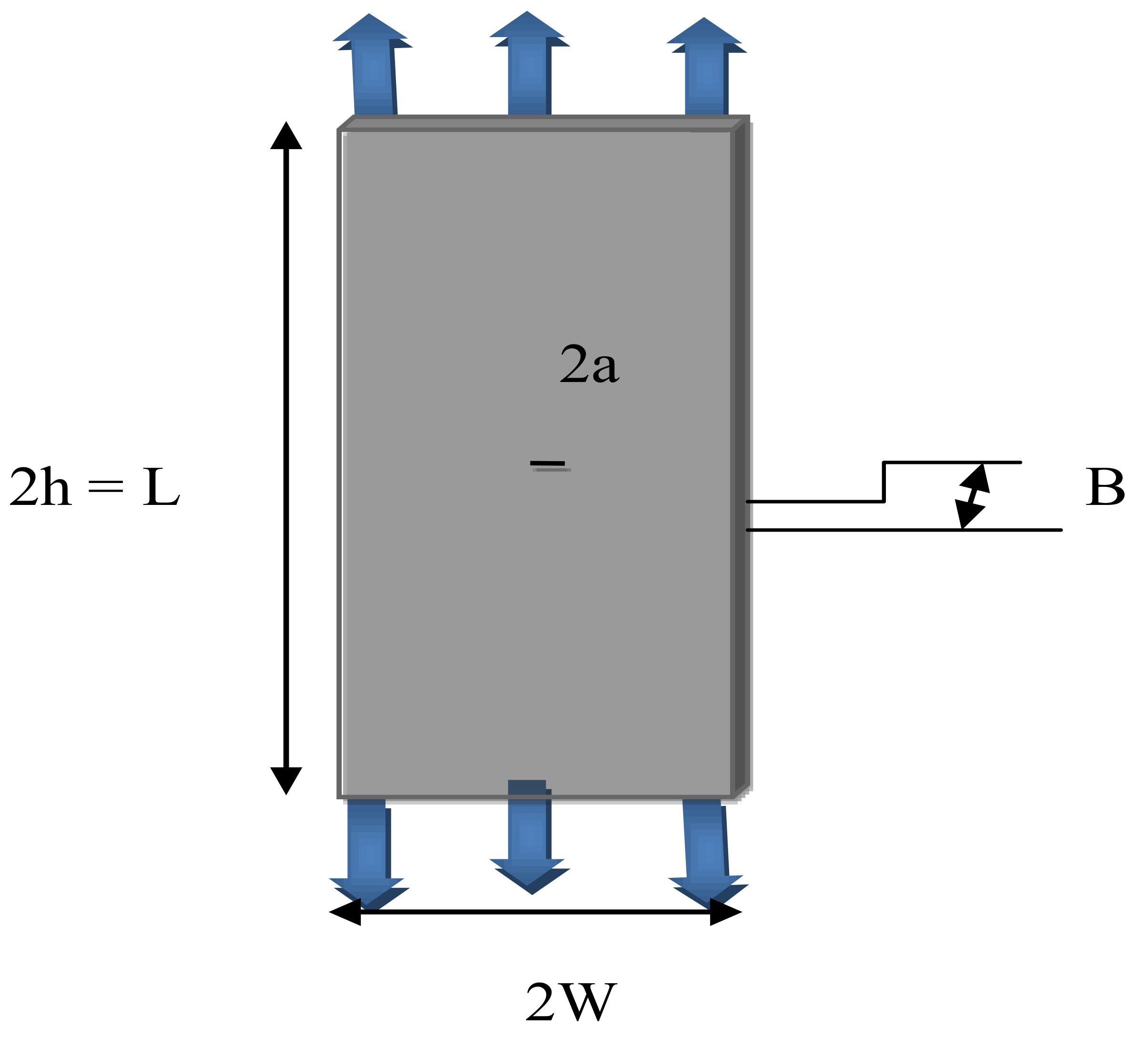
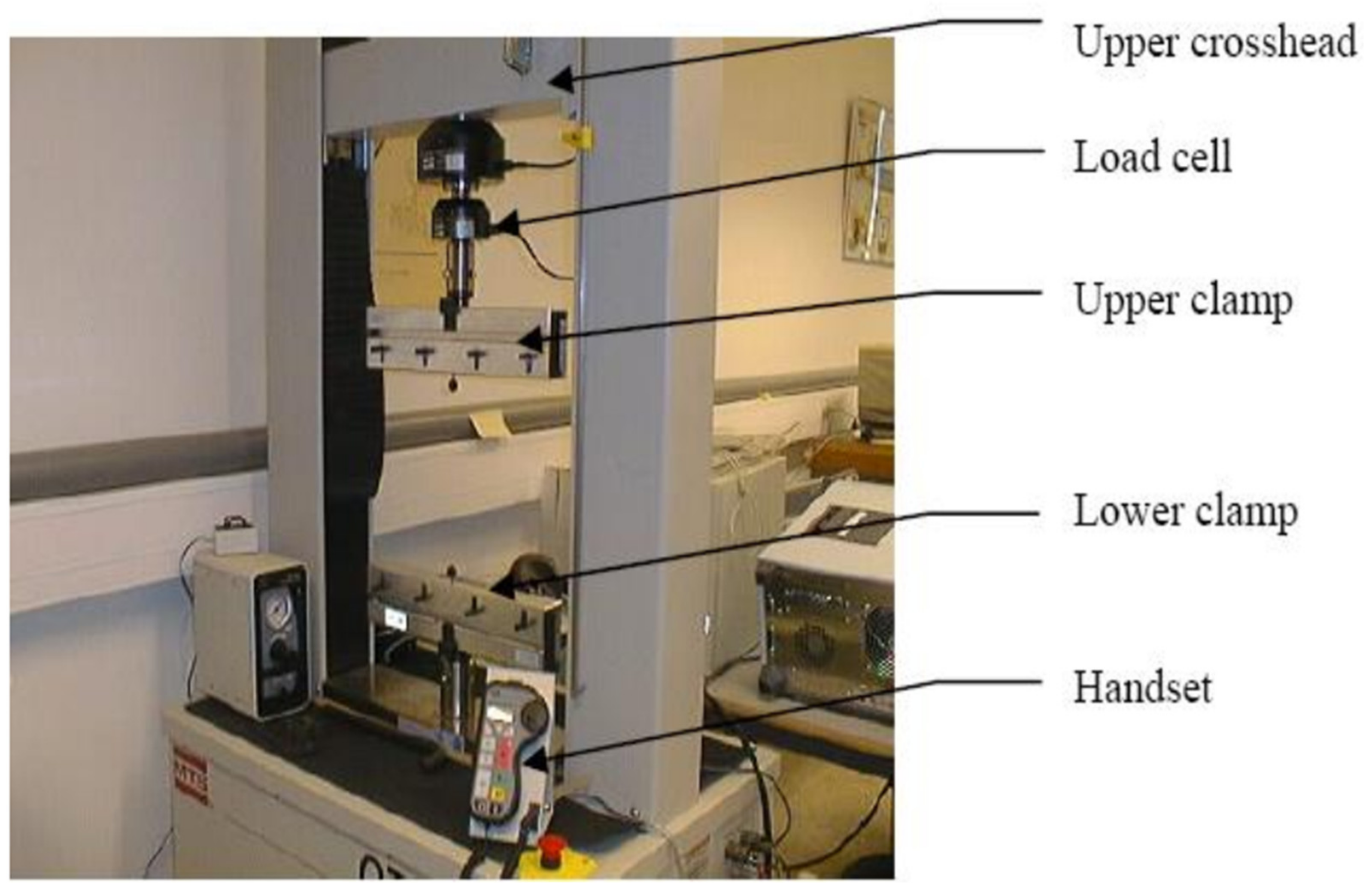
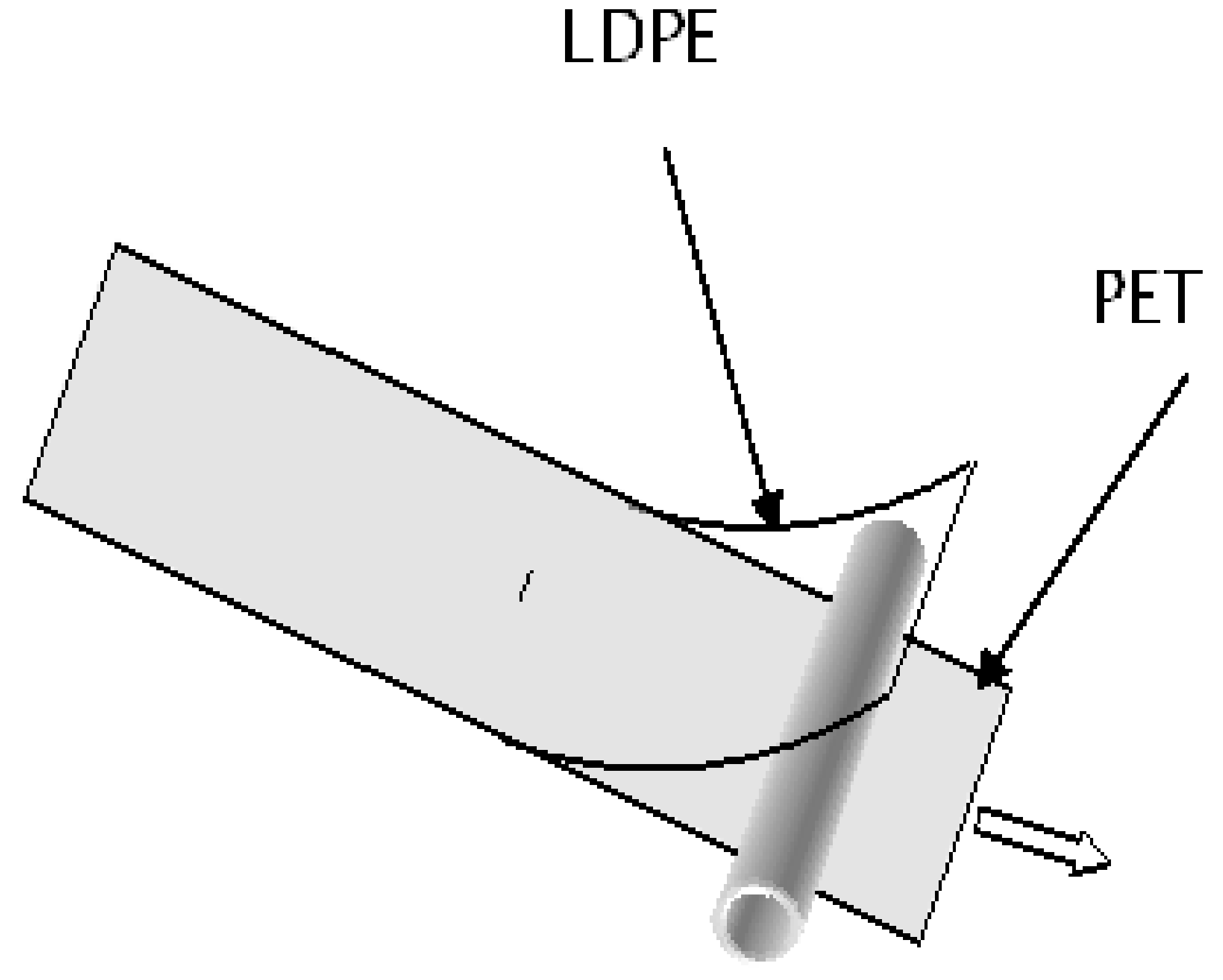
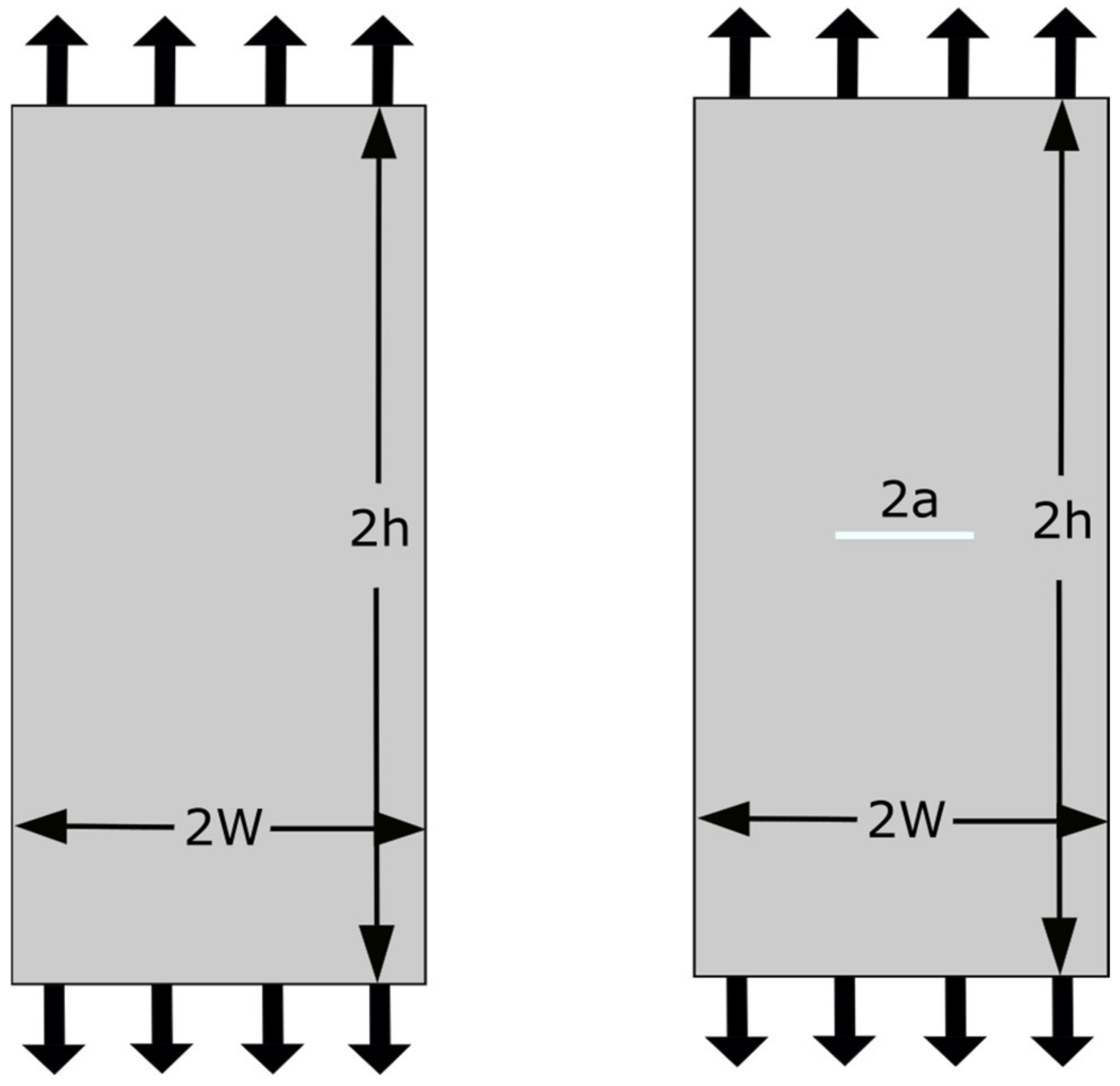
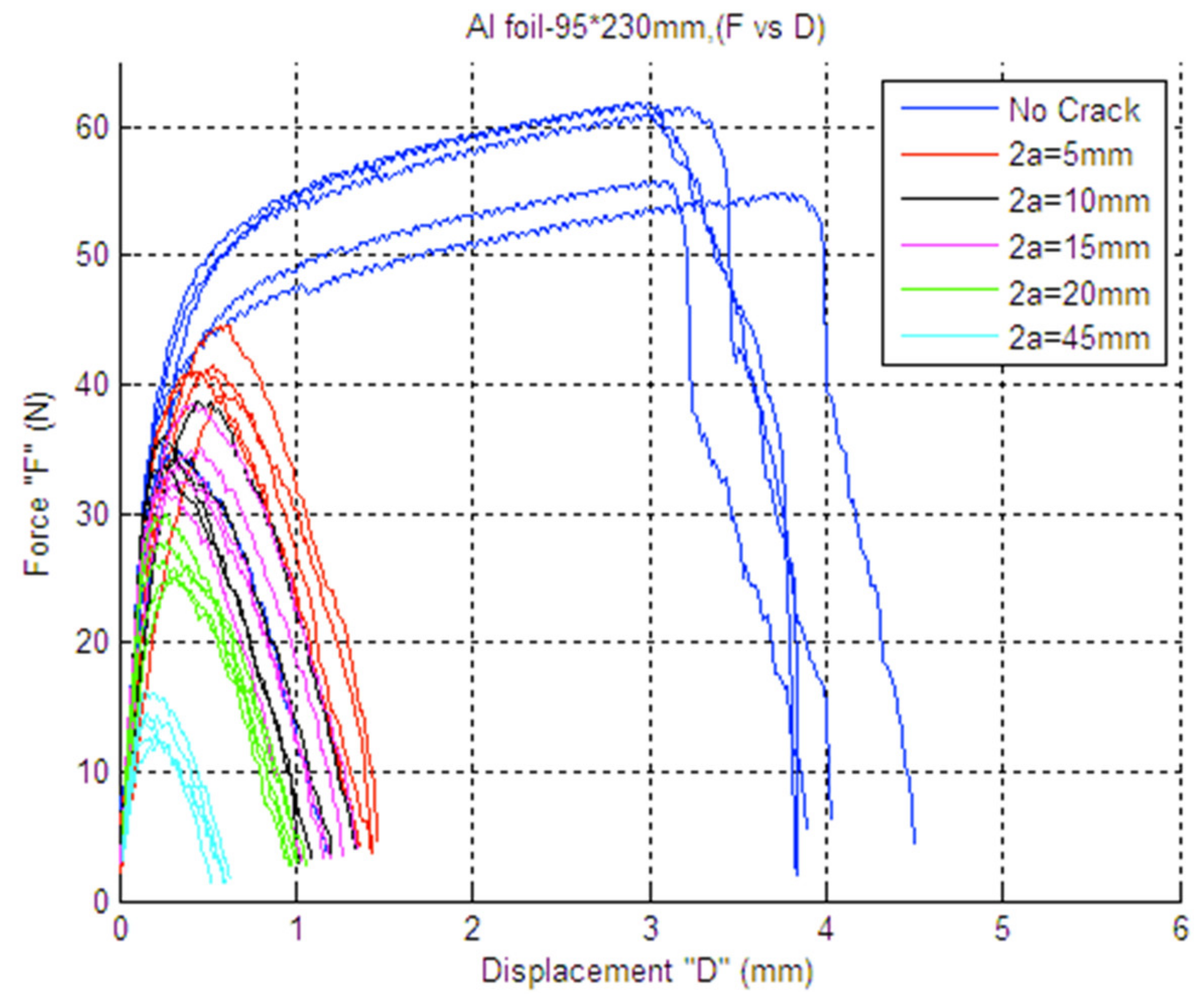
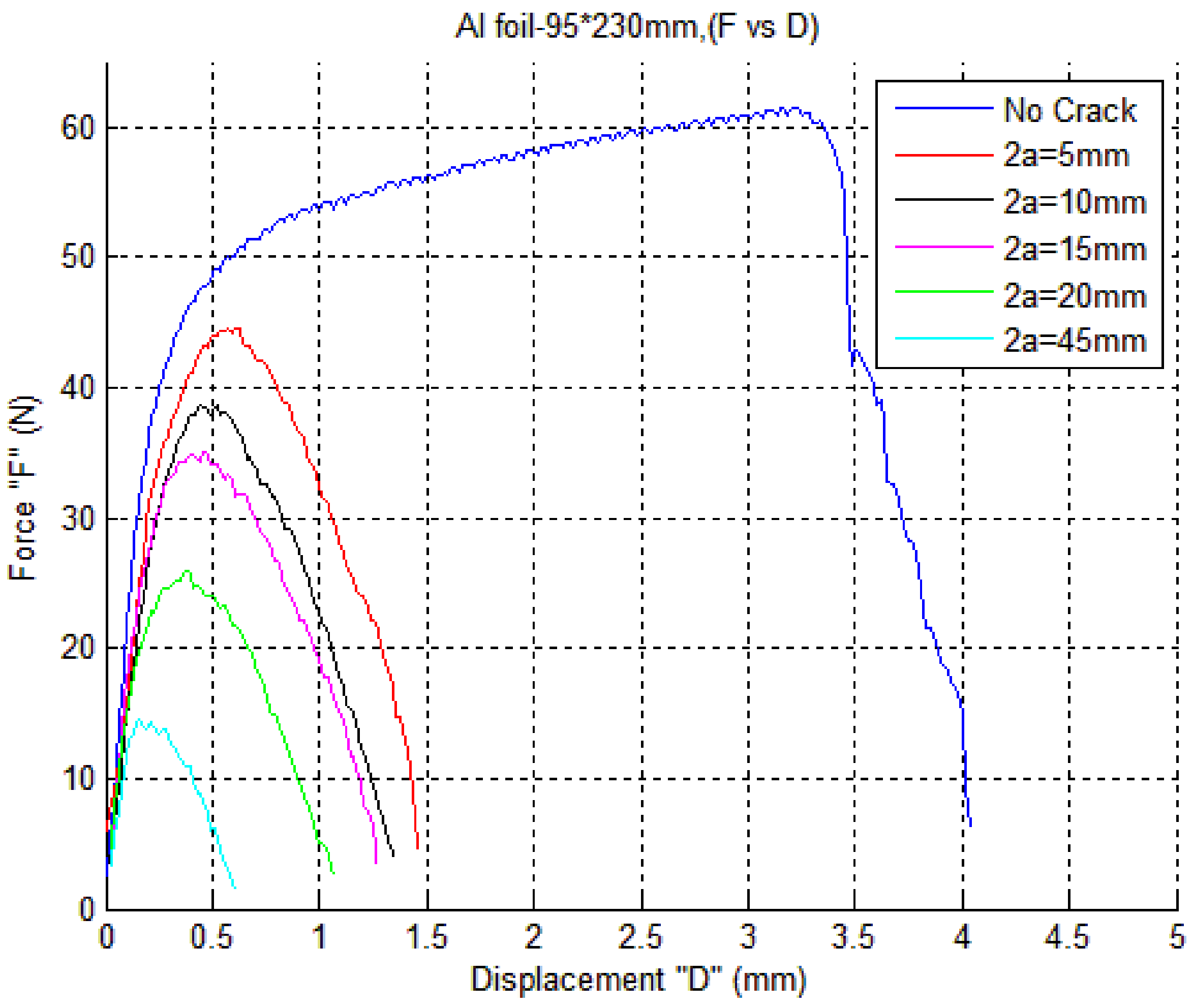
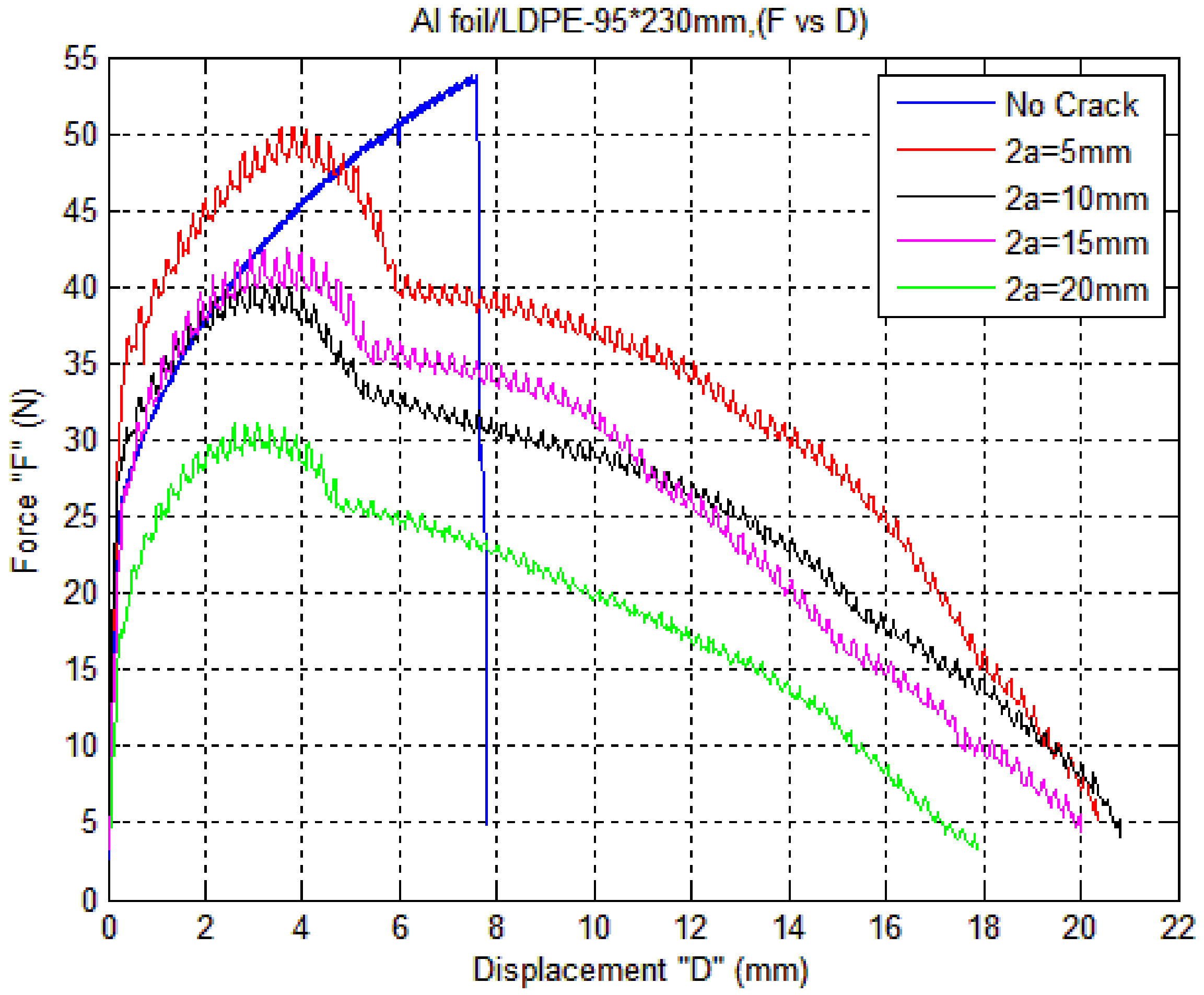
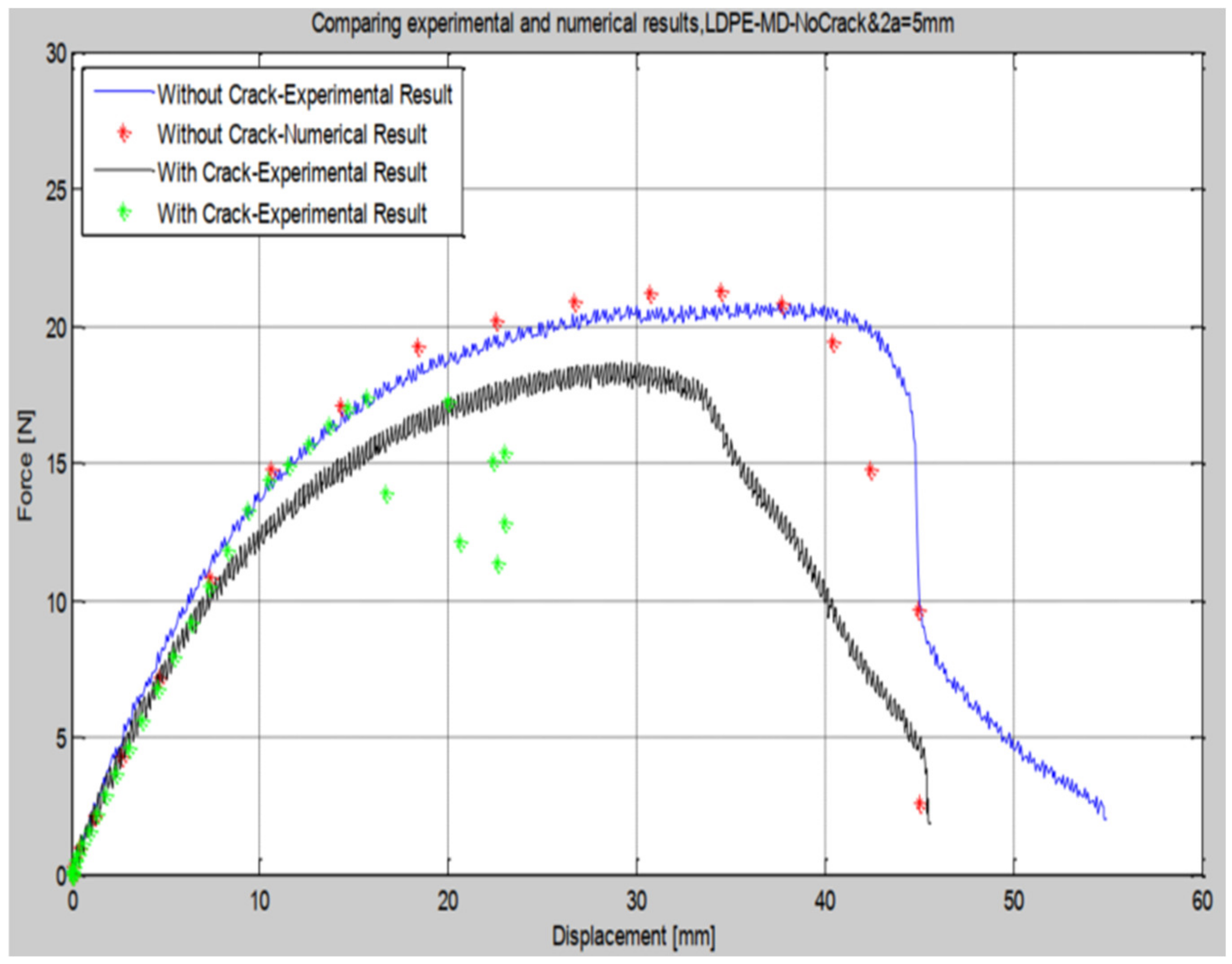

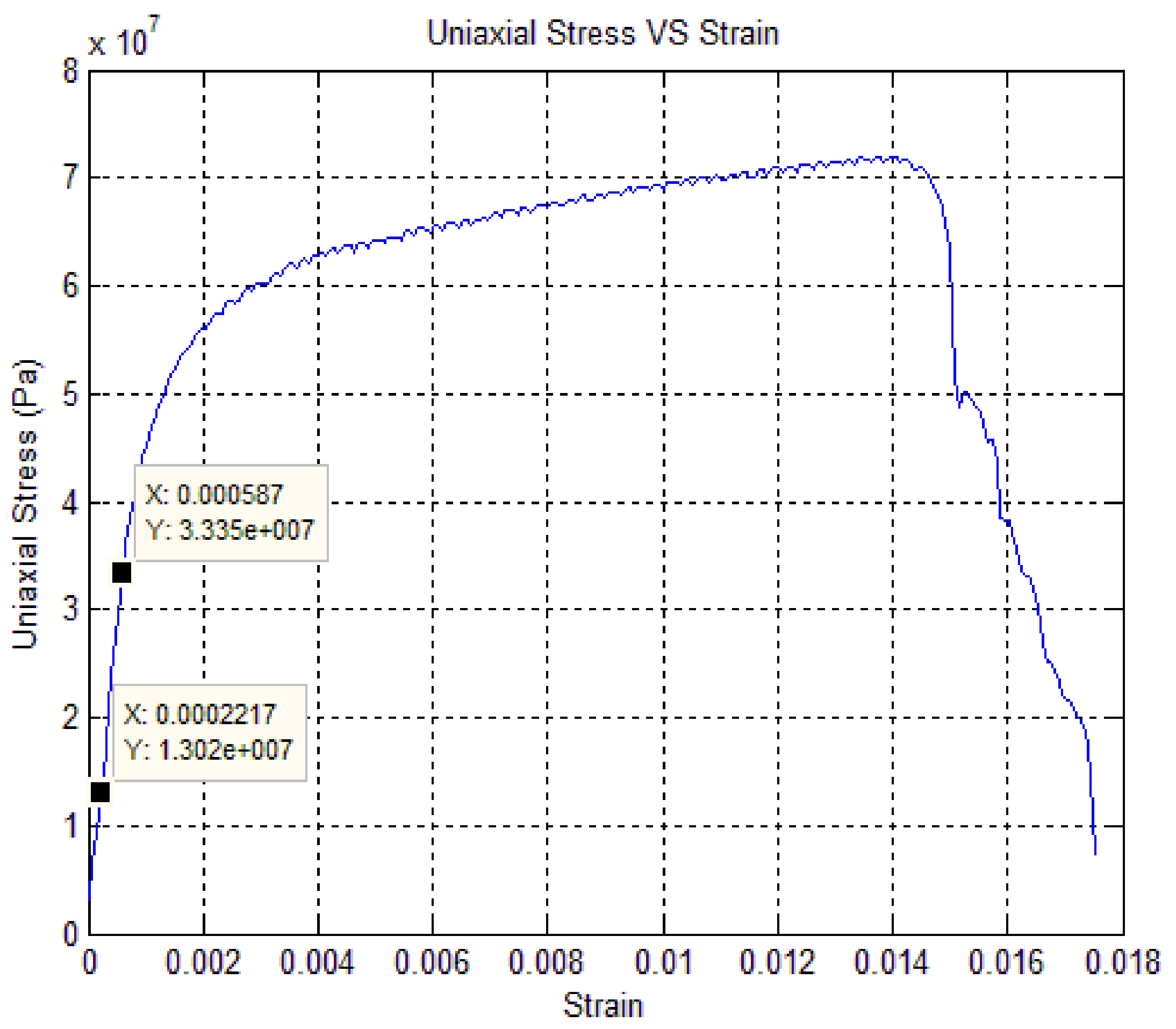
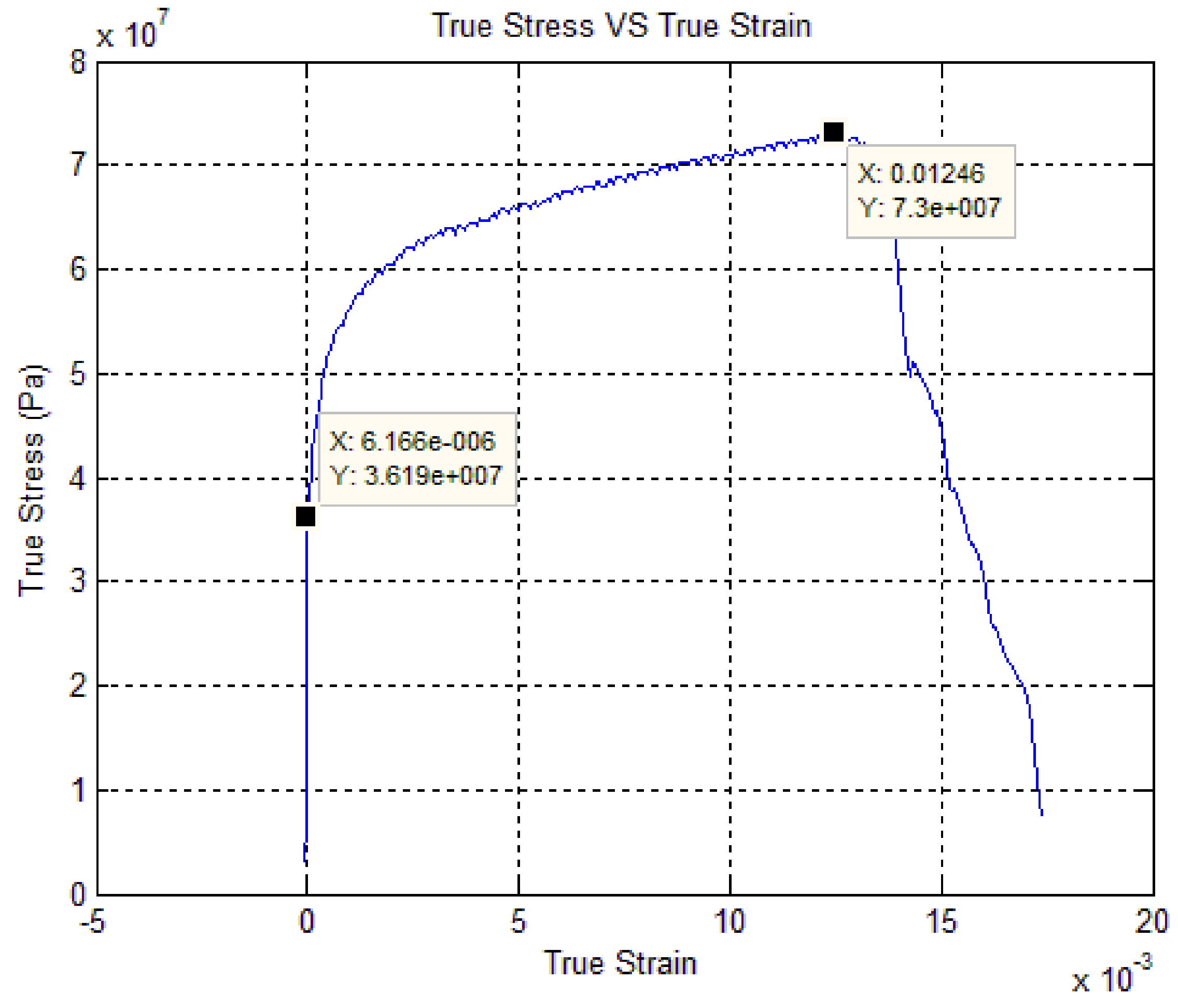

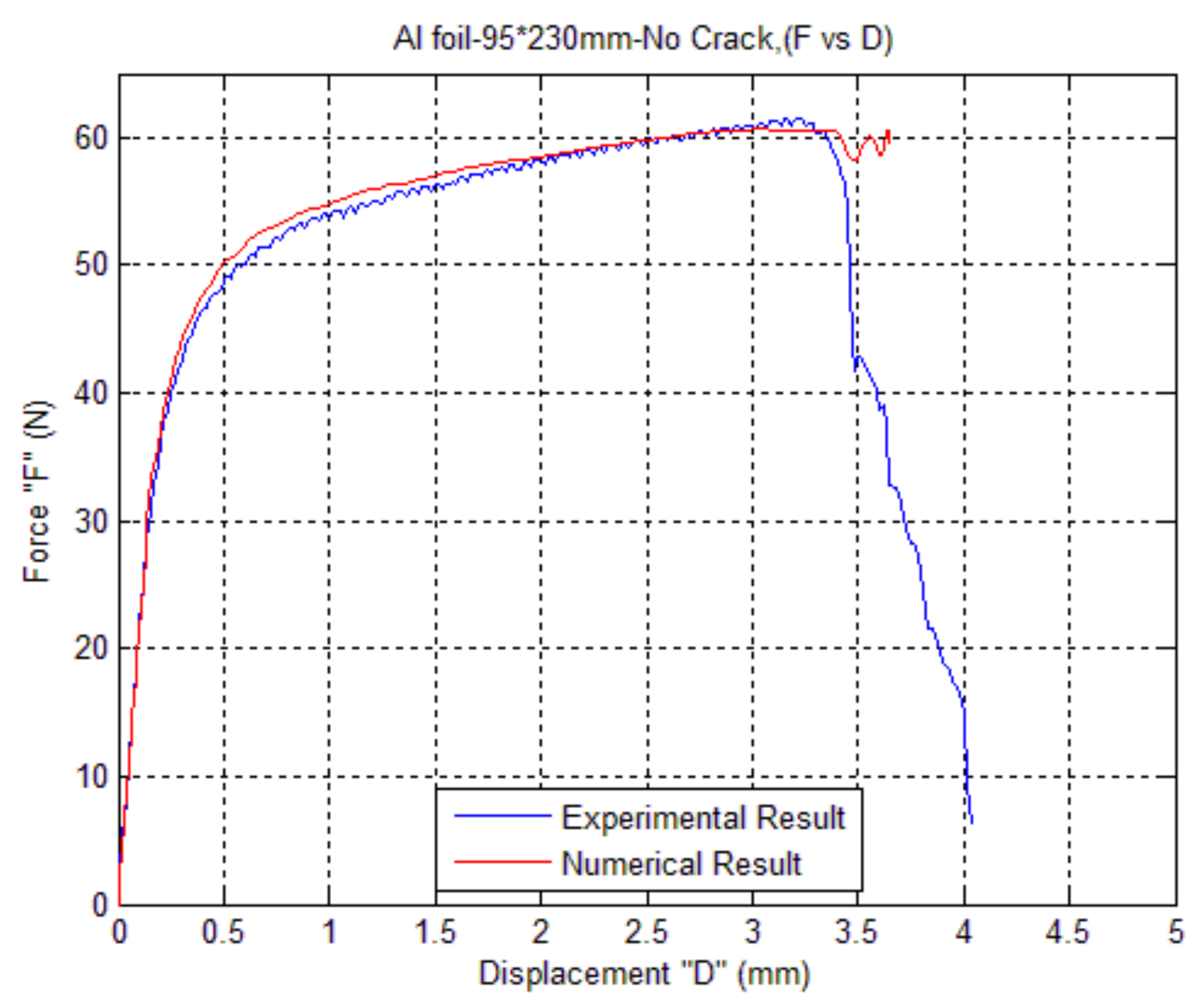
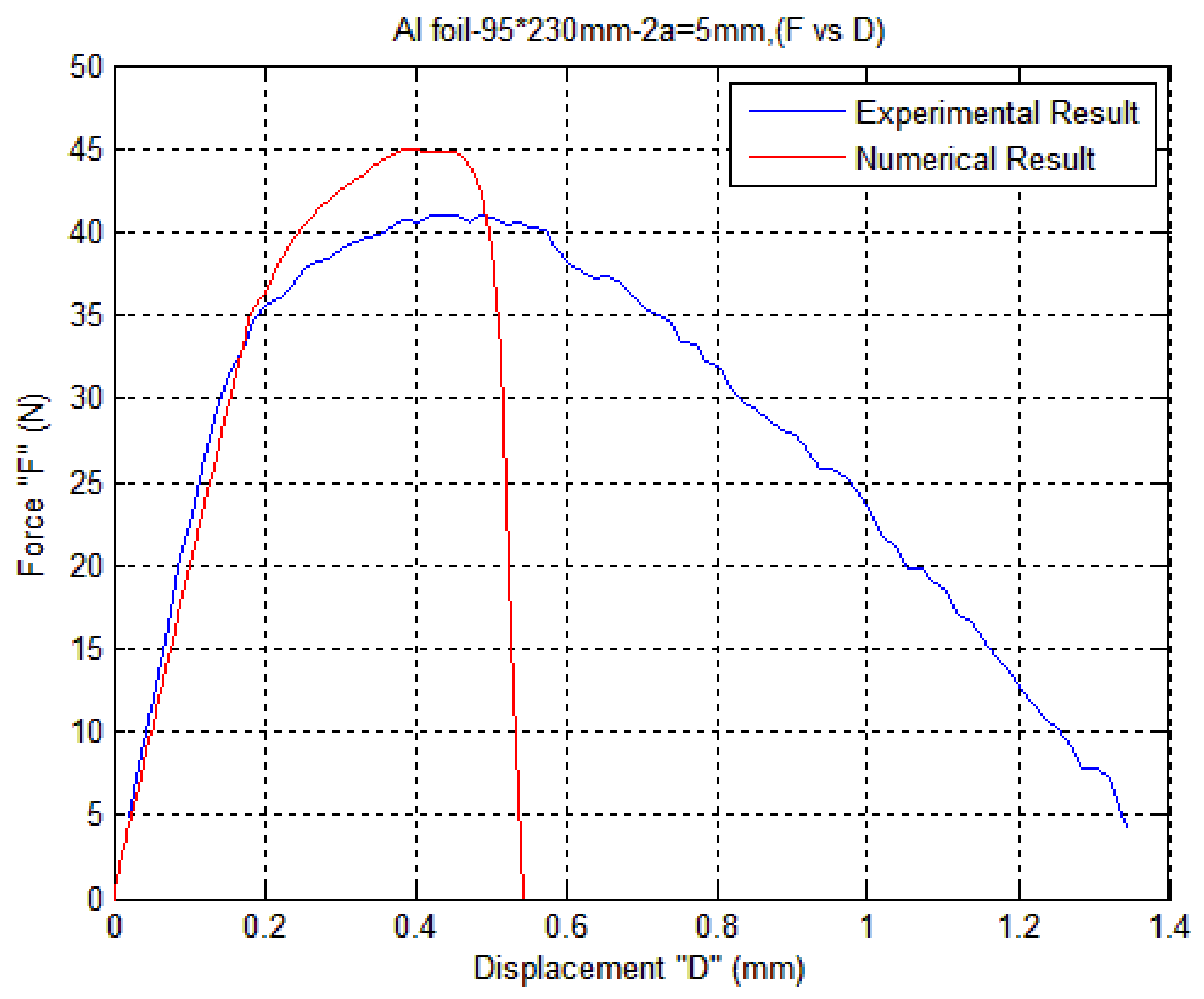


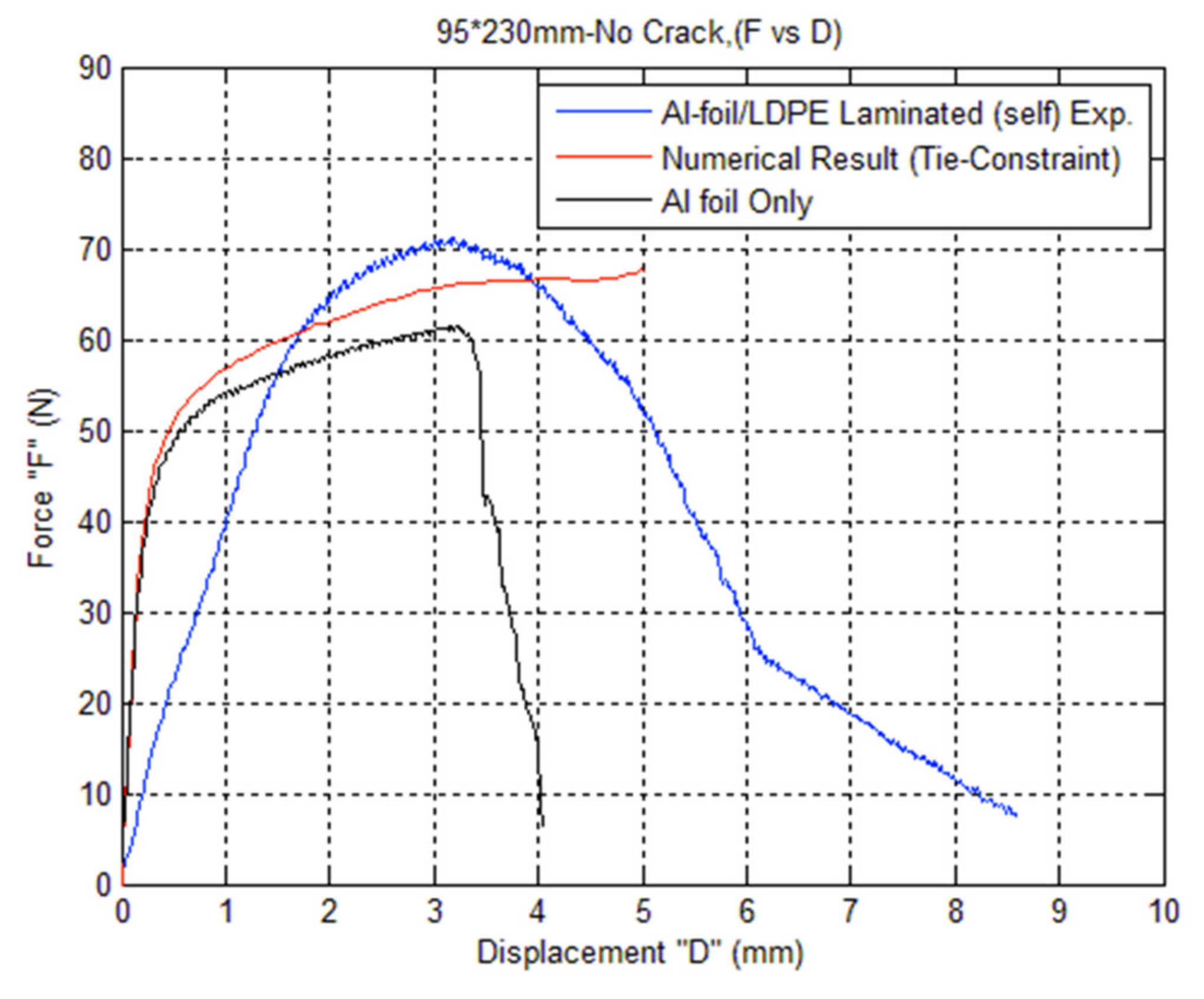

| Sr. No | Test Cases | Crack | Thickness (μm) | Dimensions (mm × mm) |
|---|---|---|---|---|
| 1 | Al Foil | With and without crack | 9 | 230 × 95 |
| 2 | Al Foil/LDPE/(w/o) Adh | With and without crack | 36 | 230 × 95 |
| 3 | Al Foil/Adh/LDPE | With and without crack | 36 | 230 × 95 |
| Crack Length (2a) (mm) | Maximum Load (F) (N) | Extension (D) (mm) |
|---|---|---|
| No Crack | 61.45 | 3.218 |
| 5 | 44.64 | 0.606 |
| 10 | 38.62 | 0.523 |
| 15 | 34.99 | 0.458 |
| 20 | 25.88 | 0.38 |
| 45 | 14.47 | 0.16 |
| Crack Length (2a) (mm) | Maximum Load (F) (N) | Extension (D) (mm) |
|---|---|---|
| No Crack | 53.8 | 7.553 |
| 5 | 50.46 | 3.792 |
| 10 | 40.26 | 2.7 |
| 15 | 42.51 | 3.666 |
| 20 | 31.1 | 2.6 |
| Crack Length (2a) (mm) | Maximum Load (F) (N) | Extension (D) (mm) |
|---|---|---|
| No. Crack | 44.61 | 4.756 |
| 5 | 38.04 | 1.653 |
| 10 | 30.07 | 0.863 |
| 15 | 28.24 | 0.334 |
| 20 | 23.59 | 0.653 |
| Materials | Fracture Strain | Stress Triaxiality | Strain Rate | Displacement at Failure (mm) |
|---|---|---|---|---|
| Aluminum Foil | 0.0001 | −5 | 0 | 0.075 |
| 0.0001 | 5 | 0 | ||
| LDPE | 0.9 | −5 | 0 | 0.9 |
| 0.9 | 5 | 0 |
Publisher’s Note: MDPI stays neutral with regard to jurisdictional claims in published maps and institutional affiliations. |
© 2021 by the authors. Licensee MDPI, Basel, Switzerland. This article is an open access article distributed under the terms and conditions of the Creative Commons Attribution (CC BY) license (https://creativecommons.org/licenses/by/4.0/).
Share and Cite
Sharif, U.; Sun, B.; Islam, M.S.; Majeed, K.; Ibrahim, D.S.; Adewale, O.O.; Akhtar, N.; Zaki, Z.I.; El-Bahy, Z.M. Fracture Toughness Analysis of Aluminum (Al) Foil and Its Adhesion with Low-Density Polyethylene (LPDE) in the Packing Industry. Coatings 2021, 11, 1079. https://doi.org/10.3390/coatings11091079
Sharif U, Sun B, Islam MS, Majeed K, Ibrahim DS, Adewale OO, Akhtar N, Zaki ZI, El-Bahy ZM. Fracture Toughness Analysis of Aluminum (Al) Foil and Its Adhesion with Low-Density Polyethylene (LPDE) in the Packing Industry. Coatings. 2021; 11(9):1079. https://doi.org/10.3390/coatings11091079
Chicago/Turabian StyleSharif, Umer, Beibei Sun, Md Shafiqul Islam, Kashif Majeed, Dauda Sh. Ibrahim, Orelaja Oluseyi Adewale, Naseem Akhtar, Zaki Ismail Zaki, and Zeinhom M. El-Bahy. 2021. "Fracture Toughness Analysis of Aluminum (Al) Foil and Its Adhesion with Low-Density Polyethylene (LPDE) in the Packing Industry" Coatings 11, no. 9: 1079. https://doi.org/10.3390/coatings11091079
APA StyleSharif, U., Sun, B., Islam, M. S., Majeed, K., Ibrahim, D. S., Adewale, O. O., Akhtar, N., Zaki, Z. I., & El-Bahy, Z. M. (2021). Fracture Toughness Analysis of Aluminum (Al) Foil and Its Adhesion with Low-Density Polyethylene (LPDE) in the Packing Industry. Coatings, 11(9), 1079. https://doi.org/10.3390/coatings11091079






